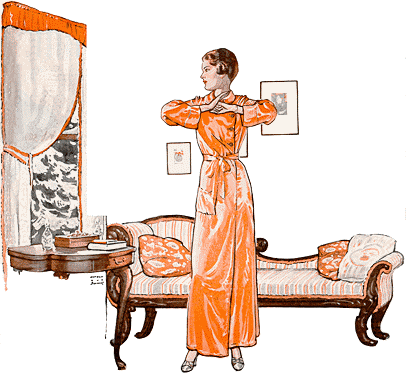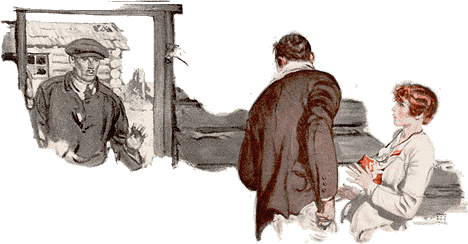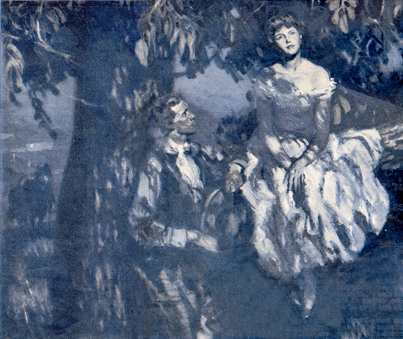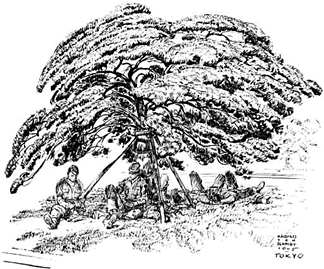



|
  |
 See Flesk Publications for details on Flesk's latest releases. |
An illustration by Harold Von Schmidt has the power to fill one's sense of wonder. He can immediately draw you into the image as if the people and situations are real. His illustrations can carry you into moments of pain, despair and hardship as well as determination, courage and triumph. He never once leaves you with a definitive ending, but instead stimulates your curiosity. You ask yourself, what will happen next? This question stays with you long after your eyes have left the image.
 He
was born in Alameda, California in 1893. [think Dean Cornwell, Hal
Foster, Robert
Lawson, Andrew
Loomis, Mahlon Blaine
and George Petty
- JVJ] As a young child his life did not start off easy. Tragedy
struck when he was orphaned at the age of five. At the orphanage,
he learned quickly how to stand up for himself, battling with
kids and drawing pictures of horses to gain acceptance. After
spending a year in the orphanage Von Schmidt went to live with
his Grandfather.
He
was born in Alameda, California in 1893. [think Dean Cornwell, Hal
Foster, Robert
Lawson, Andrew
Loomis, Mahlon Blaine
and George Petty
- JVJ] As a young child his life did not start off easy. Tragedy
struck when he was orphaned at the age of five. At the orphanage,
he learned quickly how to stand up for himself, battling with
kids and drawing pictures of horses to gain acceptance. After
spending a year in the orphanage Von Schmidt went to live with
his Grandfather.
His Grandfather had been a forty-niner and was in his early eighties at the time. He filled the young von Schmidt's mind with exciting stories of the old west. Thus began a long friendship with the old west. Von Schmidt's own experiences during his youth as a cow hand and construction worker also influenced his art. They contributed to his thorough knowledge of the workings of the human body, animals, and machinery, essentials in presenting clear and believable illustration. Von Schmidt knew the way a saddle flexed on the back of a horse, the way a wagon wheel twisted when hitting a rock at high speeds. He presented this knowledge to you as a believable event from the past, a piece of history to enthrall, excite and educate.

As a young man he stayed very active in studies and athletics. He began his formal art training at the California School of Arts and Crafts in Berkeley while still in his senior year in high school. After a year and a half in art school, he discovered that Maynard Dixon had a studio close by in San Francisco and had an open house on Saturdays. Von Schmidt not only went to meet him, but he convinced Dixon to let him model in exchange for tips and pointers on his own art. This arrangement continued for over a year. In 1920 Von Schmidt went to the Olympics in Brussels as a member of the American rugby team where they won the gold medal. He was also accepted to the team four years later. He tore the muscles in his left shoulder during the final practice and was unable to play.
In 1924, Von Schmidt traveled to New York. There he studied under Harvey Dunn at the Grand Central Art School. He married in 1927 and moved to Westport, Connecticut, getting away from the big city life.
 |
| Cosmopolitan 1932 |
| Von Schmidt worked for many of the great magazines of the day. His primary clients were Colliers, Cosmopolitan, Liberty, The Saturday Evening Post, and Sunset. In 1929 he illustrated a deluxe edition of Death Comes For the Archbishop by Willa Cather with sixty drawings . He spent two years on the illustrations and was exceptionally proud of them. He went on to illustrate only a handful of other books, focusing mainly on magazines. The remaining books are December Night and Queer Person both published in 1930, then Indian Gold in 1933 and Homespun in 1937 (see image at right). |
 |
 |
|
Tugboat Annie Wins Her Medal by Norman Reilly Raine. The Saturday Evening Post June15, 1946 |
The Saturday Evening Post tried to make a cover artist out of him, but he resisted. He was not interested in doing covers or in images of kissing couples. His focus was on illustrations, preferring to do one hundred of them rather than ten covers. His primary interest was interior artwork. He painted in oils, preferring them over tempera, which was popular among artists at the time. Many of his illustrations were quite large, in the 30"x40" range and sometimes even bigger. Choosing the larger format allowed him to paint faster and with more freedom than if he used a smaller canvas. Bold enegetic strokes appealed to him much more than constrained detail.
 Towards
the end of 1944, von Schmidt become a war correspondent for the
United States Air Force. He flew on bombing runs in B-24's and
B-25's and went on to see the first days of occupation in Japan.
Throughout this time, he sketched his observations, specializing
in the moments in-between the action. He saw more than just the
war. He captured the everyday things the average person would
do. By sketching in this way (see image at right), he was able
to record the true essence of the times for later generations.
Towards
the end of 1944, von Schmidt become a war correspondent for the
United States Air Force. He flew on bombing runs in B-24's and
B-25's and went on to see the first days of occupation in Japan.
Throughout this time, he sketched his observations, specializing
in the moments in-between the action. He saw more than just the
war. He captured the everyday things the average person would
do. By sketching in this way (see image at right), he was able
to record the true essence of the times for later generations.
HVS's importance to the American illustration world was not overlooked during his life. He was showered with awards and honors. He was a life trustee of the Artists Guild in New York and president of the Society of Illustrators from 1938 to 1941, where he was elected into the Hall of Fame in 1959. He was awarded the first gold medal by the trustees of the National Cowboy Hall of Fame in 1968, was president of the Westport Artists from 1950 to 1951 and a member of the American Indian Defense Association. He was also generous with his time to many local organizations in his hometown of Westport.

Another grand achievement was his involvement with the Famous Artists Schools. Each founding member was considered to be among the leading and most respected of the day. Being a founding member of the FAS, von Schmidt had the chance to share his knowledge of illustration with a huge audience. In 1949 his instructional Famous Artists Advanced Program (How I Make a Picture) was published. Portions were reproduced for many years in the Famous Artists Course instuctional sets which were sent out to aspiring artists across the country (for a price).

|
|
The Saturday Evening Post April 12, 1952. The Claws Of The Cat by Stuart Cloete. |
 From
daring feats of heroism to gentle depictions of the common man
and woman, Harold Von Schmidt was able to pull you into his illustrations,
leaving you with more than a well-composed image. He gave you
a story. Von Schmidt showed us the past was alive. He could make
your emotions rise to triumphant heights or drop to sadness in
a brushstroke.
From
daring feats of heroism to gentle depictions of the common man
and woman, Harold Von Schmidt was able to pull you into his illustrations,
leaving you with more than a well-composed image. He gave you
a story. Von Schmidt showed us the past was alive. He could make
your emotions rise to triumphant heights or drop to sadness in
a brushstroke.
| Thanks again to John Fleskes for taking the time to contribute to these pages. I know he would rather have been surfing... |

To learn more about Harold von Schmidt, see:
| Famous Artists Advanced Program: How I Make A Picture | Harold Von Schmidt, Institute Of Commercial Art, 1949 |
| Illustrating for the Saturday Evening Post | Ashley Halsey, Jr. Arlington House, 1951 |
| Harold Von Schmidt Draws and Paints the Old West | Walt Reed, Northland Press, 1972 |
| Von Schmidt: The Complete Illustrator | John Carroll, The Old Army Press, 1973 |
| The Western Art of Harold Von Schmidt | Walt Reed, Peacock Press/Bantom Book, 1976 |
| The Illustrator In America 1880-1980 | Walt and Roger Reed, The Society Of Illustrators, 1984 |
|
Text copyright © 2001 by John Fleskes. Illustrations are copyright by their respective owners. This page designed & © 2001 by Jim Vadeboncoeur, Jr. Updated 2011. |
